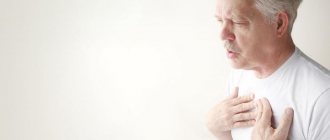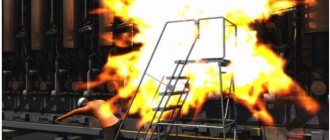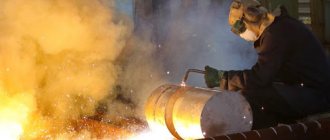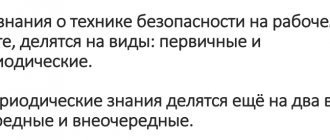Concept of work injury
Trauma is any damage to the tissues of the human body and disruption of the normal functioning of organs. If the accident is related to the performance of one’s official duties at the enterprise, it falls under the definition of an industrial injury.
Cases of health deterioration specific to a given profession are classified as occupational diseases. Workers receive them as a result of their work in hazardous conditions. The respiratory organs and musculoskeletal system are most often affected. In the Russian Federation there is a list of hazardous professions of categories 1 and 2 and diseases associated with them. It is valid throughout the country, for any organizations, regardless of their size and subordination.
Enterprises, depending on the technological process, have different categories of harmfulness. They negatively affect the body with the following phenomena:
- high and low temperatures;
- release of harmful gases into the atmosphere;
- strong light radiation;
- force fields;
- dustiness of the air;
- drafts;
- vibration;
- increased noise threshold;
- conditions of being underground or at height.
All these factors also relate to the causes of industrial injuries and occupational diseases.
At enterprises of the Russian Federation, all managers are obliged to take measures to prevent and reduce industrial injuries: fencing off dangerous places, providing workers with special clothing, improving working conditions, and others.
There are cases when it is impossible to completely eliminate the negative impact on a person. For example, working in northern conditions, especially in open areas. Most often these are builders, drivers, forestry workers, and sailors.
In the south, agricultural workers are forced to spend all day in the field under the rays of the scorching sun at air temperatures above +30 ⁰C. Under similar conditions, workers construct buildings, lay pipelines and other communications.
What is it about
An industrial injury is damage to tissues or organs due to the external impact of negative production factors on the worker’s body.
The law establishes that injuries at work are subject to special control, and all accidents in companies are not only investigated and recorded by regulatory authorities, but also affect the amount of insurance premiums paid by the employer. The state, for which occupational injuries as a social problem is of great importance, pays great attention to its prevention. Thus, the Russian Federation has joined the international campaign to promote the concept of “zero injuries,” and now officials recommend that regional authorities and employers approve programs to improve working conditions and safety.
Read more: How to approve a “zero injury” program at an enterprise
The purpose of such documents is not just to list the main types of injuries in the organization, but also to identify measures to minimize negative consequences, including financial ones. It's time for employers to understand: employee disability leads to a decrease in profits and an increase in social benefits.
Let us recall that Article 219 of the Labor Code of the Russian Federation regulates the employer’s obligations to provide safe working conditions for employees who meet occupational safety and health requirements, and Article 212 requires eliminating or reducing the impact of harmful and hazardous production factors. At the same time, the employee’s duties, according to Art. 214, includes compliance with safety regulations, regular instruction and training on labor protection, and the use of necessary protective equipment when working.
Occupational and non-occupational injuries
The causes of industrial injuries are classified according to the location where the accident occurred:
- in production;
- outside the enterprise while performing official duties;
- on the way to work and home;
- on the territory of the enterprise not related to production;
- household
Work-related injuries include those sustained on the territory of the enterprise while performing actions related to job responsibilities. When a worker or employee performs his work directly at the workplace. These include injuries sustained during the lunch break.
Occupational injuries can occur outside the enterprise, when a person is on a business trip, driving a company vehicle, going to work and home after a shift. If his movement or activity is related to the performance of duties specified in the employment contract and movement to and from the place of their implementation.
Coming home from work has its limitations. This is not the entire route home, but only the route directly from work to your place of residence. For example, after a worker entered a store and then fell and twisted his ankle, he should no longer leave work. An injury sustained before entering a retail or other establishment may be considered an industrial injury. Official transport and travel in it are considered being at work.
Not all injuries sustained on the premises of an enterprise are considered occupational injuries. Injuries received by a stranger or during free time are not considered industrial injuries and are considered accidental.
Domestic injuries are not related to the worker’s performance of his duties, and the accident occurs outside the enterprise.
Similarly, during a long business trip, occupational injuries include injuries received in a specific place. If it is impossible to strictly delimit the territory for performing his duties, for example, the supplier visits many organizations. In this case, the limitation is made in time.
From 8 a.m. to 5 p.m., the employee performs official duties. If a dispatched specialist falls in the evening, then it is a domestic injury.
Benefits and allowances for an employee injured at work
In Russia, legislation provides for one-time or multiple compensation for employees who have received an occupational disease if they are officially employed. Assessing damage and paying compensation is the direct task of the employer, who determines its amount. Typically compensation is expressed as:
- one-time compensation payment;
- monthly compensation (if the employee cannot work, i.e. has lost his ability to work);
- compensation for damage (in case of temporary disability).
The normative act regulating the amount of payments is the Labor Code of the Russian Federation. Thus, one-time compensation for damage cannot exceed 85 thousand rubles, monthly compensation should not exceed 65 thousand, and compensation for loss of ability to work should not exceed 270 thousand.*
Labor Code of the Russian Federation
The normative act regulating the amount of payments is the Labor Code of the Russian Federation.
In order to receive benefits, you need to document the fact of receiving the disease. This is done when contacting a medical institution, where, after undergoing an examination, medical workers must notify the employer of the employee’s injury. A conclusion about the presence of an occupational disease is drawn up on the basis of an act written as a result of an inspection of production for the presence of the subject of injury.
The Social Insurance Fund is responsible for issuing compensation benefits. According to GOST, here, in addition to the conclusion, the employee must provide the original document confirming his identity, a copy of his work record book, a report on the presence of an occupational disease, and an original certificate of average salary.
Classification of injuries by type
The causes of industrial injuries are divided into objective and accidental. The latter include isolated accidents on the territory of the enterprise that are not related to work or the specifics of production. For example, a person twisted his leg out of the blue or stared at welding and “caught bunnies” and suffered eye damage.
Objective reasons include:
- technical;
- sanitary and hygienic;
- organizational;
- physiological – personal.
The largest number of work-related injuries occur due to technical reasons. This is a malfunction of equipment and tools, poor insulation of power cables.
The workplace must have protective screens and shields that protect against the ingress of chips, scale and other dangerous objects.
Welding stations are fenced around the perimeter to protect the eyes of people passing by. The worker himself must wear a special suit and protective equipment in the form of glasses, boots, and gloves.
Sanitary and hygiene reasons
Reasons that are sanitary and hygienic factors that negatively affect health:
- bad light;
- drafts;
- low and high temperatures;
- air pollution;
- evaporation of harmful substances;
- poor ventilation;
- vibration;
- noise:
- lack of sanitary facilities.
In a poorly lit workshop, you may not notice the dangerous movement of individual pieces of equipment, a crane carrying a load, or an approaching electric vehicle. Drafts and cold provoke colds, inflammation, and the development of occupational diseases. The lack of household premises violates the standards of personal hygiene of people.
With poor ventilation, harmful substances accumulate in the air, which enter the respiratory system, affect the mucous membranes and blood, and cause occupational diseases.
Drafts, vibration and noise gradually cause irreversible processes in the human body: chronic inflammation, tremors, diseases of the musculoskeletal system.
Poor organization of work areas
Organizational reasons often lead to injuries due to poorly cleared aisles and paths and unpaved sidewalks in winter. The enterprise administration must take care of:
- correct placement of equipment;
- compliance with transportation standards;
- training in safe working methods;
- fencing hazardous areas;
- creating storage areas;
- all employees have special clothing appropriate to their profession;
- installation of sound and light alarms on all lifting and transport mechanisms.
The organization of labor begins outside the territory of the enterprise. What sidewalks do people use to get to the enterprise? The condition of the tracks at the plant itself. If there are holes and debris everywhere, then the likelihood of foot injury increases sharply.
Violation of transportation rules, improper slinging and stacking of cargo leads to its fall. Clogged aisles and driveways threaten to bring down everything that has accumulated in them onto people passing and driving by.
High-risk areas should be fenced and accessible only to people working there. For example, the crane cabin must be closed. The key is kept by the workshop mechanic and is given only to the crane operator who starts her shift. Similarly, chemical equipment, electrical devices and vibration stands are installed in separate rooms.
The availability of regularly issued protective clothing and the use of protective equipment are important factors in reducing occupational injuries.
Regular training of workers in safe work practices should not be neglected. In addition to information, constant verification of this knowledge is necessary. Each employee should know the scope of their responsibilities and not try to do someone else’s work. The machine operator should not independently remove and install large parts on the machine if he does not have a sling operator’s license. Likewise, the crane operator listens to commands and works only with persons who have passed a special exam and have a document.
With the noise of the equipment, it is difficult to hear approaching vehicles. Loads moving at height are especially dangerous. Therefore, all cranes, machines, electric trolleys must be equipped with signals that are sharply different in nature from the hum of machine tools, welding installations and other units.
Sanitary
At the beginning of the shift, the worker must change into overalls in normal conditions, where there are no drafts and it is warm. After your shift, wash yourself and remove any dirt that has ingrained your skin and contains harmful substances. During the shift, depending on the profession and working conditions, rest breaks are taken. The worker should be able to spend 10 to 15 minutes in comfortable conditions.
If the enterprise does not have a canteen, rooms for meals must be equipped. In addition to the table and chairs, they are equipped with equipment for heating food, a boiler or an electric kettle with boiling water.
Psychophysical
Physiological causes of injuries are called personal. They depend on the state and mood of the person. For example:
- accumulation of fatigue;
- bad feeling;
- nervous overload;
- stressful state;
- monotony of work.
When assigning a job, the physical characteristics of the body and anthropometric data should also be taken into account. For example, in schools for training machine operators, the height and gender of the graduate were always taken into account during the distribution. The tallest and strongest guys were placed on large machines. The girls received turning machines DIP 100 and small single-column planing and drilling units. On them, the weight of the workpiece does not exceed 10 kg, the tool 2 kg.
The master should not allow a person in poor health to perform his duties. His inattention will lead to industrial injuries. The patient should be referred to a doctor.
Special attitude towards persons under the influence of alcohol. They should be immediately suspended from work and an act of violating safety regulations and being drunk at work should be drawn up. This is as serious an offense as driving while intoxicated.
Topic: Prevention of industrial injuries and occupational diseases in enterprises
Topic: Prevention of industrial injuries and occupational diseases in enterprises.
The essence of industrial injuries and occupational diseases.
1. Work injuries
An industrial injury is a sudden damage to the human body and loss of ability to work caused by an accident at work. Accidents include occupational diseases, occupational poisoning and, in exceptional cases, general diseases. In turn, the repetition of production-related accidents is considered an industrial injury.
The following types of accidents are distinguished:
1) by the number of victims: single and group;
2) by severity: mild, severe and fatal;
3) depending on the circumstances: production-related, not production-related, but work-related, and domestic accidents.
In the event of an industrial accident, the manager of the site where the accident occurred is obliged to do the following:
• organize first-aid measures for the victim and hospitalize him;
• take the necessary measures to prevent the recurrence of such an accident;
• urgently report the incident to the head of the enterprise and the trade union committee;
• together with the senior public safety inspector and safety engineer, investigate the accident within 3 days;
• draw up an accident report in the prescribed form N-1 in two copies and send them to the head of the enterprise, who must approve this report and certify both copies with the seal of the organization. In this case, one copy is given to the victim, and the second (together with the investigation materials) is stored for 45 years in the archives of the enterprise.
If a group, fatal or serious incident occurs, the head of the enterprise is obliged to immediately report this to the technical inspector of the trade union serving this enterprise, a higher economic body, the prosecutor's office at the location of the enterprise, Gosgortekhnadzor or Energonadzor for objects under their control. Moreover, each such case is subject to a mandatory special investigation by a technical inspector of the trade union with the participation of representatives of the administration, trade union committee, higher economic body, and, if necessary, with the participation of Gosgortekhnadzor or Energonadzor within a period of no more than 7 days.
For production-related accidents, the enterprise administration is responsible, and the victim is paid temporary disability benefits in the amount of average earnings at the expense of the enterprise itself. In case of disability that occurs as a result of injury or other damage to health, the victim is awarded a pension; in addition, he is required to compensate for material damage due to loss of ability to work in the amount of the difference between the lost average monthly earnings and the disability pension.
Accidents involving employees and other persons during the performance of their labor duties and work on the instructions of an organization or individual entrepreneur are subject to investigation and recording, including:
¨ employees performing work under an employment agreement/contract;
¨ citizens performing work under a civil contract;
¨ students of educational institutions of higher and secondary vocational education, students of educational institutions of secondary and primary vocational education, undergoing practical training in organizations;
¨ persons sentenced to imprisonment and attracted to work by the administration of the organization;
¨ other persons participating in the production activities of the organization and individual entrepreneur.
Occupational accidents are investigated and recorded: injuries resulting from bodily harm to others; acute poisoning; heatstroke; burn; frostbite; fatigue; electric shock, lightning, radiation; insect and reptile bites; bodily injuries caused by animals; damage received as a result of explosions, accidents, destruction of buildings, structures and structures, natural disasters and other emergency situations, resulting in the need to transfer the employee to another job, temporary and permanent loss of ability to work.
2. Combating occupational injuries
One of the most important conditions for the fight against industrial injuries is a systematic analysis of the causes of their occurrence, which are divided into technical and organizational. The first type of causes of industrial injuries manifests itself in most cases as a result of design flaws in equipment, insufficient lighting, malfunction of protective equipment, and protective devices. The second type of reasons includes non-compliance with safety regulations due to the lack of training of the workers themselves, low labor and production discipline, improper organization of work, and lack of proper control over the production process at the enterprise.
As for the results of injury analysis, they largely depend on the reliability and thoroughness of the preparation of reports on industrial accidents, especially with regard to the formulation of the cause of the accident. The purpose of analyzing the causes of accidents at work is to develop measures to eliminate and prevent accidents. When carrying out such an analysis, monographic, topographical and statistical methods are used.
The monographic method provides for a multifaceted analysis of the causes of injuries directly in the workplace. At the same time, they study the organization and working conditions, the condition of equipment, inventory, and tools. This method is effective in combination with statistical analysis of the state of labor protection.
The topographic method allows you to determine the location of the most frequent cases of injury, for which the number of accidents during the analyzed period is noted on the enterprise plan, which indicates workplaces and equipment. As a result, it becomes possible to pay more attention to improving working conditions in those workplaces where accidents most often occur.
The statistical method is based on the study of quantitative indicators of data from accident reports at an enterprise. In this case, the coefficients of frequency, severity of injuries and disability are mainly used.
Frequency factor
(CN) determines the number of accidents per
1000 employees during the reporting period and is calculated by the formula:
where Hc is the number of accidents during the reporting period with loss of ability to work for more than 3 days; Av – average number of employees.
Gravity coefficient
injury rate (Kt) shows the average number of days of incapacity for work per accident during the reporting period, and is determined by the formula:
,
where Day is the total number of days of incapacity due to accidents; Nc – number of accidents during the reporting period.
Disability rate
(Кн) reflects the actual severity of accidents, since when calculating this coefficient, those accidents for which the disability did not end in the reporting period are taken into account. It also allows you to take into account losses associated with the complete withdrawal of the dead from the labor process:
Kn = Kt · Kch.
The results of accident investigations are considered by employers in order to develop and implement measures to prevent them, resolve issues of compensation for harm to victims (members of their families), and provide them with compensation and benefits.
3. Analysis of the causes of accidents and diseases.
Analysis of the causes of accidents at work is one
well, one of the most important tasks of an enterprise, ensuring such economic indicators as labor productivity and quality of products.
The process of preventing industrial injuries, which is a very important production task, is inextricably linked with the constant improvement of the system for recording and analyzing the causes of accidents at work.
The purpose of analyzing the causes of accidents at work is to develop specific measures to eliminate them. As a result of the analysis, causal connections of accidents with design flaws in production equipment, with shortcomings in the organization of production processes and training of workers in safe techniques and work methods are established. The analysis of industrial accidents is preceded by their investigation and recording, since the quality of the investigation depends on the correctness of the identification of causes, the reliability of the analysis and the effectiveness of preventive measures, since the causes must follow from the circumstances of the accident, and preventive measures, in turn, must be closely linked to the causes .
The main difficulty in analyzing industrial injuries lies in unambiguously determining the main causes of accidents, the analysis of which should include the following stages:
1. identification of all causes of the accident that led to injury;
2. establishing the relationship between the causes that directly led to the accident;
3. determination of the main cause of the accident (preferably technical) that caused injury to the victim.
The causes of accidents are presented in the following Figure 1:
Rice. 1.
Causes of industrial injuries
An analysis of accidents, diseases and emergencies that have occurred in Russia in recent years has made it possible to identify the following main causes of accidents and injuries at work:
¨ human factor – 50.1%;
¨ equipment, machinery – 18.1%;
¨ technology of work execution – 7.8%;
¨ environmental conditions – 16.6%;
¨ other factors – 7.4%.
As can be seen from the data obtained, currently there has been a noticeable increase
the proportion of accidents and incidents occurring due to incorrect actions of maintenance personnel. This is often due to a lack of professionalism, as well as the inability to make optimal decisions in a complex critical situation under time pressure.
The cause of accidents in the Russian Federation is often a departmental-technocratic strategy that leads to the construction of facilities with obviously backward technology, as well as cost savings to ensure the necessary safety.
As a result, the Russian Federation annually spends 1-2% of its gross product on eliminating the consequences of various types of accidents. Obviously, knowledge in the field of life safety will help solve these problems, which should:
¨ increase the training of the entire population of Russia;
¨ ensure accounting of all types of accidents, emergencies and their consequences;
¨ give the population a complete understanding of how to protect themselves from dangers;
¨ to ensure personal and collective security regimes in normal conditions and in emergency conditions.
Based on an analysis of the causes of accidents and illnesses at work, the enterprise administration and the trade union committee draw up a labor safety action plan, which is included in the “Labor Safety” section of the collective agreement or in the labor protection agreement attached to this agreement. After approval of the draft collective agreement at the general meeting of the enterprise’s employees, the administration concludes an agreement with the trade union committee no later than February of the current year. The administration of the enterprise and the trade union committee must regularly report to the collective of workers and employees on the fulfillment of their obligations under the collective agreement
4. Measures to improve occupational safety
Effective measures include qualified implementation
introductory, on-the-job, periodic (repeated), unscheduled and ongoing safety briefings for workers.
Employees entering the enterprise for the first time and students sent for practical training must undergo induction training. The introductory briefing introduces safety rules, internal regulations of the enterprise, the main causes of accidents and the procedure for providing first aid in the event of an accident.
Employees who re-enter the enterprise or are transferred to another place of work, and students undergoing practical training must undergo on-the-job (primary) training. This training introduces you to safety rules in the workplace, as well as personal protective equipment.
Periodic (repeated) briefings are carried out to test the knowledge and ability of workers to apply the skills they acquired during induction training and in the workplace. Regardless of qualifications and work experience, trade and catering workers must undergo this type of training (at least once every 6 months)
At the moment, the current situation regarding the legal provision of life safety at work is changing somewhat, and this is due to the fact that significant changes have already been made to a number of basic regulatory and legislative acts to ensure life safety at work.
Unscheduled training is carried out at the workplace when replacing equipment, changing a technological process, or after accidents due to insufficient previous training.
Routine briefing is carried out after identifying violations of rules and safety instructions or when performing work under a work permit.
Schematically, management tasks to ensure occupational safety in the workplace, the causes of industrial injuries, and socio-psychological factors that reduce occupational safety in the workplace can be represented using Figure 2.
Rice. 2
. Factors that cause occupational injuries
Every business should have a book to record safety instructions.
Special course training in safety precautions is organized for persons who, due to working conditions, are exposed to increased danger (stokers, electricians, machinists, welders, etc.). Course training is also mandatory for foremen who organize rigging, installation, repair and loading and unloading operations.
The knowledge of course participants is checked by a commission and recorded in a protocol, on the basis of which those who pass the exam are issued a certificate. Recertification is carried out within the time limits established for each specialty.
To prevent accidents and occupational diseases, enterprises are equipped with safety rooms or corners where posters, diagrams, safety instructions, personal protective equipment, instruments for measuring noise, light, vibration, etc. are placed. Systematic lectures, conversations, and briefings using visual aids, films and television programs are an effective way to promote safety at work.
Conclusion
The most pronounced processes of technogenic changes in the qualitative characteristics of the environment are developing in the production sector, which is the most significant in the professional work activities of specialists in various fields. The progress achieved in the field of production during the period of the scientific and technological revolution was accompanied and is currently accompanied by an increase in the number and increase in the level of dangerous and harmful factors in the production environment.
Thus, the creation of internal combustion engines solved many transport problems, but at the same time led to increased injuries on roads and gave rise to difficult problems in protecting people and the natural environment from toxic emissions from cars.
Human production activity constantly has an increasing negative impact on the quality of the natural environment, contributing to the emergence of unfavorable environmental factors that form up to 25-30% of human pathology.
The constant increase in technical equipment in various areas of human activity is accompanied by an increase in the energy level of anthropogenic factors in the modern environment. Data on the scale of the impact of hazardous and harmful factors on humans and the environment over time, unfortunately, indicate a constant increase in injuries, the number and severity of diseases, the number of accidents and disasters and the factors causing them.
Consequently, without taking into account the current situation, it is difficult to plan the further development of production and the economy as a whole, because Developing technologies must be subject to increased safety requirements.
Causes of occupational diseases
Occupational diseases are a type of industrial injury, but they arise gradually, usually of the same type in people working in equally harmful conditions. They are provoked by:
- outdated technologies;
- unequipped workplaces;
- poor sanitation;
- failure to use protective equipment;
- retreat from technology;
- the need for contact with harmful substances.
When creating casting molds, the mixture is compacted by vibration. Molders fill the following boxes directly between the shakers. The floor is constantly shaking. Similarly, there are large machines with platforms for installing parts and turning on equipment. The lack of modern instruments showing the exact coordinates of the cutter and load forces the worker to stand on a vibrating metal platform for a long time. This gradually leads to industrial injuries - damage to the musculoskeletal system.
Galvanic baths and containers for electrolysis must be covered with lids on top. Vapors are removed into ventilation ducts. Active forced ventilation is installed in the room. Older equipment does not have such protective measures. Workers inhale harmful fumes.
A large percentage of diseases are caused by drafts and working at low temperatures indoors or outdoors in freezing temperatures. For work in winter conditions, in addition to special clothing, a schedule of heating and hot meals, and warm bathrooms are provided.
Technical causes of industrial injuries
The main condition for combating injuries at work is considered to be a systematic analysis of the causes. To understand them, there are methods for analyzing the causes of industrial injuries that specialists resort to.
The manifestation of technical reasons is the result of design flaws in the mechanism, poor lighting or faulty safety equipment. Such phenomena can occur suddenly when a mechanism malfunctions, or they occur when machines and automation gradually fail. In addition, technical reasons for the occurrence of injuries at work include the imperfection of the ongoing technological process - the lack of automatic notification of a problem, loading raw materials into a grinding machine by hand, and so on.
Classification of industrial injuries
To simplify analysis and statistics, all types of industrial injuries are classified according to several parameters:
- degree of severity;
- type of injury;
- one person or 2 or more are injured;
- according to the place where they occur most often.
In accordance with GOST on industrial injuries, the degree of severity distinguishes between mild, moderate and severe injuries. Separately, they are fatal. Special commissions are created for them and prosecutors are involved in the investigation.
According to the type of injury, they are distinguished:
- cuts;
- bruises;
- fractures;
- burns;
- poisoning
Cuts of varying severity most often occur when working with sharp instruments or piercing objects. For example, cooks using knives when cutting and cutting food. Construction workers installing barbed wire fencing or working with glass. Machine operators have sharp edges on their cutters. Drain shavings cut deep into the body.
Slippery floors, spilled oil, parts and containers protruding into the passage lead to varying degrees of bruises.
Fractures occur when a person falls, as well as heavy objects on him. A loose part, a hole in the road or poor lighting can cause serious damage.
Burns are divided into: thermal, chemical, electrical. Thermal ones occur upon contact with hot objects. Chemical burns are caused by contact with acids, alkalis and other harmful substances that corrode skin and tissue. In case of electric shock, an electrical burn appears at the site where the wire touches.
For example, in metallurgy, workers most often suffer thermal burns. It is not necessary to touch the hot workpiece. Standing nearby without appropriate felt clothing is enough to cause burns to exposed skin. The temperature of the molten metal is 1500 ⁰C and higher.
Each enterprise has an occupational safety department that investigates and properly records every accident. In addition to the type, the severity, cause of injury and location are indicated. All data is analyzed, statistics are compiled that identify the most dangerous places and professions.
Types and categories of occupational diseases
Occupational diseases: what is it, payments, how to apply
Typically, the types of injuries at work are divided into 5 groups of occupational diseases.
- Group 1: diseases resulting from contact with chemicals.
- Group 2: diseases caused by prolonged contact with dust.
Diseases caused by prolonged contact with dust
- Group 3: various physical effects causing, for example, damage to vision or hearing.
- Group 4: injuries caused by a psychological factor.
- Group 5: injuries and diseases arising from exposure to unfavorable environmental conditions and biological factors.
Poisonings acquired at work are also grouped into the category of “acute” occupational diseases. The definition of “acute” means the occurrence of a disease as a result of a single, short-term impact on the body, as opposed to, for example, psychological factors.
Important! Negligent handling of chemicals and other substances, failure to comply with safety precautions when working with them is the main cause of chemical poisoning.
The influence of the environment on industrial accidents
The environment has a direct impact on the production process. With temperature changes, high dust content in the air, and high humidity, a worker’s performance may change for the worse. This results in rapid fatigue, the worker’s endurance decreases, and attention to work is reduced, which can lead to an industrial accident. Frost, snow, hail, rain, heat and other weather phenomena affect the employee’s condition, in which a person can make dangerous mistakes at work. For example, fog or ice can lead to a collision between trains on a factory railway track.
Psychological factor in the occurrence of injuries at work
Work-related injuries can occur even against the background of unpleasant emotions as a result of reluctance to work. The psychological causes of dangerous situations at work are divided into three types:
- The disrupted motivational part of human actions. In this case, he does not want to take actions that would ensure security. Under the influence of stress, a person may either not notice a health threat or deliberately ignore it. The effect of such causes can be a long-term process or even permanent, if measures are not taken to eliminate them. The first step should be consultation with a psychologist.
- The indicative part of human activity is violated, which manifests itself in ignorance of methods and standards for ensuring safety.
- The performing part is violated - failure to follow the instructions and safety rules due to various psychophysiological characteristics of the worker (poor coordination of movement, low vision, etc.).








